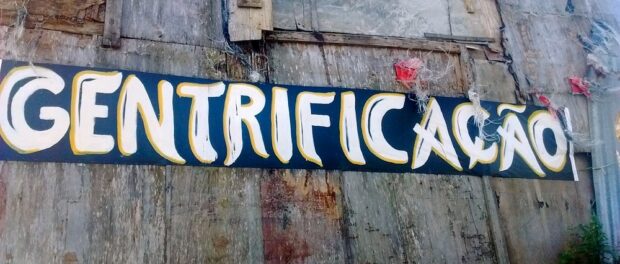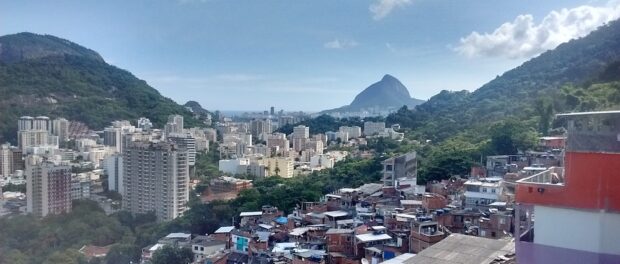
As has been reported on this site, many Cariocas have been forced from their homes in the build-up to the Olympics. This article asks whether this is a special case in Rio, world-famous as a divided city where the fabulously wealthy live in close proximity to those in poverty, or whether it is a more systemic problem related to the Olympic Games and other mega-events. Answering this question requires us to take a look back to see how other Olympic host cities have prepared to host “the greatest show on earth.”
First, we need to define what we mean when we say people are being forced from their homes. This of course includes the many violent evictions seen in recent years—and intensifying in recent months—in the city’s favela communities, but also includes less violent, more insidious means. In some areas, citizens have been priced out of a community when the value of the land has increased but the wealth of the residents has not, the process we know of as gentrification.
Finding numbers for those who have been forcibly evicted is difficult enough, particularly because some Olympic host countries where evictions occurred in large numbers also lack basic freedoms including freedom of the press (such as Seoul 1988 and Beijing 2008). Calculating numbers for those forced to relocate due to increased costs and other factors associated with gentrification is even more difficult, as it is often impossible to link a person or family relocating specifically to a mega-event; gentrification often appears an inevitable process, an accumulation of circumstances that results in people choosing to relocate. These issues are often ignored, but historically appear to affect many more people than violent evictions.
Evictions in previous host cities
The first mega-event case where we know forced relocation of large sections of the population was a major issue was in preparation for the Seoul Games in 1988. According to a report into the effect of mega-events on housing by the Centre on Housing Rights and Evictions (COHRE) in 2003, 720,000 residents were forcibly evicted in the build-up to the event, mostly at the hands of Korean dictator General Chun Doo-hwan.
Huge numbers of the population of Beijing were forcibly relocated in the lead-up to the Beijing Olympics in 2008. COHRE estimated that by 2004, 300,000 of the city’s residents had been relocated, with descriptions of the violent tactics used by demolition squads eerily reminiscent of recent events in Rio. Legal challenges by Beijing residents who had been evicted were often not heard by courts, and lawyers who attempted to bring these issues to trial were often harassed and even arrested under bogus allegations such as stealing state secrets.
Forced evictions have been far rarer in host cities with democratic governance. In London around 450 tenants were evicted from the Clays Lane housing estate in the east of the city. In Rio, however, 77,206 people were removed from their homes between 2009 and 2015, according to the recently released dossier on human rights violations relating to the 2016 Olympics.
Gentrification and the Right to the City: An Olympic history
Less visible, however, is the process of gentrification, yet it is much more common. Increasing the economic prosperity of a city is often hailed as a reason to host the Olympic Games. Leaving the flawed economics of this justification aside, the limited wealth produced by the Olympics very rarely finds its way to those most in need. Indeed, wealth is often created at the expense of the poorest residents of host cities by increasing the value of property to the extent that residents can no longer pay rent. This has been common in previous Olympic host cities—in Sydney rents rose by up to 40% in the lead up to the Games in 2000, in Salt Lake City rents rose before and after the Winter Olympics in 2002, in Vancouver it was an explicit part of Olympic planning to regenerate the Downtown Eastside area of the city and in London the Olympics exacerbated the city’s pre-existing housing crisis. The 2012 London Olympics exacerbated this problem, despite being sold to the population as a solution.
Such rent rises are a symptom of deeper changes in the urban environment which are often deliberate policies of exclusion in violation of the Right to the City initiated by the city as part of Olympic preparations. Another symptom is the removal or restriction of public space, controlling space so only certain groups (i.e. those with money) can access these spaces, thereby transforming democratic spaces into spaces of exclusion. The area around the Olympic stadium in Atlanta, host of the 1996 Games, became the Centennial Olympic Park which was sold to residents as an open public space but condemned by urban geographer Charles Rutheiser as “an ephemeral simulation of an open public space.”
In Vancouver an area of wetland called Eagleridge Bluffs, popular with dog-walkers and trekkers, was destroyed to make room for a highway to Whistler, where the skiing events took place. In London whole sections of the population are being forced to leave the city as the housing issues in that city make it unaffordable for those on low wages. In Rio, we are seeing important public spaces being destroyed and transformed into private spaces for profit, exemplified by the construction of the Olympic golf course atop the Marapendi nature reserve and the Olympic Park itself, that occupied state land which after the Olympics will be owned by the developers responsible for the Park and developed into luxury housing.
Once space is privately owned, it becomes much easier to police. Companies can remove people who are hampering their ability to generate profit much more easily than the city government which exists, at least in principle, for all citizens. In Atlanta, leading up to the 1996 Olympics, around 30,000 people were forced from their homes in the inner city due to rising rent pressures. These people, as Director of the Metropolitan Atlanta Task Force for the Homeless Anita Beaty notes, were disproportionately African-American. Further criminalized by aggressive laws against the poor, many homeless people were given the option of either leaving the city or being arrested so that the streets would be “clean” during the Games. Despite the immorality of this policy, it seems to have stuck, having been copied in various host cities in recent years.
In Sydney laws were passed to criminalize dissent and difference, and despite the emphasis on aboriginal reconciliation in the rhetoric of the organizers, genuine reconciliation was never really pursued. A similar law in Rio may charge protesters as terrorists. In Vancouver, residents–particularly in the Downtown Eastside area–were hassled by police for petty offenses including drunkenness, jaywalking and skateboarding, even as the IOC tries to add skateboarding to the Summer games program. This illustrates the key difference between development and gentrification: the former aims to improve an area by supporting the development of existing residents and their communities, while the latter improves an area through a short-sighted “quick fix” approach of exchanging the residents for new, wealthier ones.
Gentrification à la Carioca
In Rio, the police pacification program has brought an increased perception of safety and with it, the process of gentrification, as is evident in the first community to experience pacification, Santa Marta. In this community, housing costs have roughly doubled in the seven years since the Pacifying Police Unit (UPP) was installed and a wealthier class is moving in, attracted by the stunning views and bohemian lifestyle. Further, these newer, wealthier residents shun various aspects of traditional favela life, opting not to participate in community meetings, for example. Santa Marta is a community in the process of rapid change with some residents being priced out of an area where they have lived all their lives. A similar process is occurring in Vidigal and other favelas in the South Zone, as described by urban geographer Christopher Gaffney. For him, gentrification is one of the deliberate objectives of the pacification policy.

In the build up to the Rio 2016 Games, then, we are not only seeing one of the largest campaigns of forced evictions in a democratic country, but also a more insidious shift in the city, ensuring the poor are further excluded from areas of the city and in some cases forcing them to leave the city entirely. This is the result of policies which seek to incorporate land into the city for developers to increase profit. What little effort there was to incorporate residents in planning processes now looks tokenistic and naive.
The Olympics are being used by the City of Rio to remove the poor from its urban center, both through forced removals of communities like Vila Autódromo and through gentrification of favelas like Santa Marta and Vidigal. Furthermore, this development is not unique to Rio; similar policies can been seen with sporting mega-events around the world, which end up expanding the wallets of the rich and exclusion of the poor.
References
Lenskyj, H. (2000) Inside the Olympic Industry: Power, Politics, and Activism. Albany: State University of New York Press.
Lenskyj, H. (2002) The Best Olympics Ever? Social Impacts of Sydney 2000. Albany: State University of New York Press.
Rutheiser, C. (1996) Imagineering Atlanta: Making Place in the Non-Place Urban Realm. London: Verso.
Shaw, C. A. (2008) Five Ring Circus: Myths & Realities of the Olympic Games. Lancaster: New Society.
Adam Talbot is a doctoral researcher at the Centre of Sport, Tourism and Leisure Studies at the University of Brighton, UK. He is undertaking an ethnographic project focusing on social movements and activism at the Rio 2016 Olympic Games.

